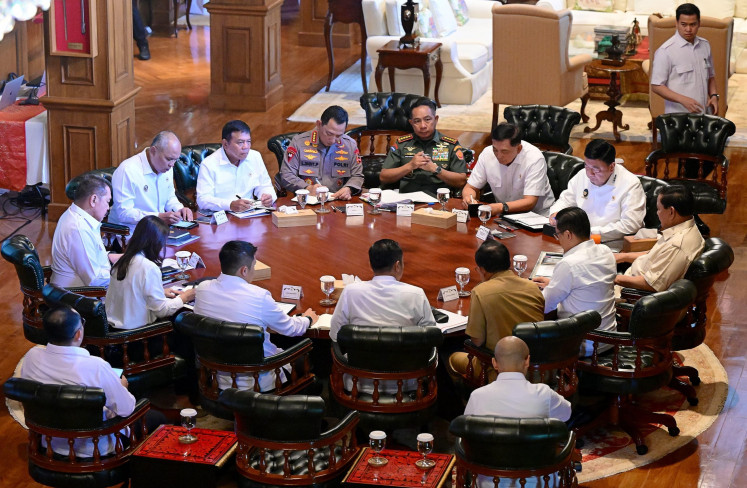Popular Reads
Top Results
Can't find what you're looking for?
View all search resultsPopular Reads
Top Results
Can't find what you're looking for?
View all search resultsRabindranath Tagore : Remembering a modern poet
Today would have been the 151st birthday of Rabindranath Tagore – the first non-European to win the Nobel Prize in Literature in 1913
Change text size
Gift Premium Articles
to Anyone
T
oday would have been the 151st birthday of Rabindranath Tagore – the first non-European to win the Nobel Prize in Literature in 1913.
His compositions are the national anthems of two nations – India’s “Jana Gana Mana” and Bangladesh’s “Amar Shonaar Bangla”. The composer of Sri Lanka’s national anthem, “Sri Lanka Matha”, was a student of Tagore and the song was inspired by Tagore’s style.
Tagore’s poetry is spiritual, and his captivating personality earned him a prophet-like reputation in the West. He is also regarded as a revered cultural figure and a spokesman of the East. But, how many of us are aware of Tagore’s great love for Indonesia, strengthened during his sojourn from Aug 17 to Sept 29, 1927, in Sumatra, Java and Bali?
Tagore’s symbolic love expressed in his poem “To Java”, written in Batavia, reminisces of a glorious relationship of sharing and mutual respect. The poem ends with a deep yearning for union between two closely connected cultures — India and Indonesia.
Tagore was a firm believer of the “Vishwarupa” (Eternal Form) of mankind whose universal expression remains nebulous due to the non realization of its potential and divine character. As an enlightened soul, he remained on a continuous quest to generate awareness among diverse entities and races. Tagore’s journey to the Indonesian archipelago was one of his ongoing discoveries of an “Asian Identity”, which belonged to a common cradle of civilization.
To him, the process of development of a conscious being began with the upbringing of children in a free and liberated environment. He abhorred implanting loads of knowledge without generating an enabling consciousness and understanding of reality. The founding of the Vishwa Bharati World University in Shantiniketan in 1918 was Tagore’s way of bringing young minds of diverse nationalities and races together under one umbrella, aimed at building bridges between varied civilizations, customs and cultures.
He visualized the shackles within and attempted to expose them, for “he who sees his chains, knows how to unchain his soul from bondages — be it social, political or religious.” Tagore could see the dark clouds of dogmas and used his genius as poet, painter, dramatist, singer, composer and a social philosopher to dissipate them.
In August 1927, he started a journey to feel the land and people’s pulse in Belawan, Batavia, Surabaya, Solo, Yogyakarta, Bali and Bandung. It was mainly to connect with the intellect and culture of the region and to mobilize support for his university. In the process, the multifaceted artist discovered many strands of fine arts that he carried back and incorporated into the curriculum of Vishwa Bharati, including the art of making batik and Javanese dance forms.
Children and young minds being his focal point, he visited the Muhammadiyah pesantren in Solo, Gontor in Surabaya and Ki Hadjar Dewantara’s Taman Siswa in Yogyakarta to share his knowledge and experience.
At the time of Tagore’s visit, his works were well known in Java through translations by people like Noto Soeroto. In fact, Soeroto was so enamored by his literary and spiritual guru that he named his son after him. Tagore’s close friend Soeriosoeparto, a Javanese nobleman, also contributed to the poet’s popularity by translating many Dutch writings on Tagore. In Surakarta, a road was named after him, called Tagorestratt (present day Jl. M.T. Haryono).
Though distressed to see “the crumbling ruins of a proud civilization strewn like a vast heap of futility”, Tagore aspired to a day “when the unvanquished man will retrace his path of conquest, despite all barriers, to win back his lost human heritage”. He felt that, “There could not be any union along the path of universal competition for power and material goods, but a meeting was possible on the intellectual and spiritual plane through an effort to understand each other.”
In Java, he came in contact with Dutch and Indonesian archaeologists and teachers and worked out a plan for the exchange of scholars, students and artists between Indonesia and his university at Shantiniketan.
From Java and Bali, Tagore’s companions brought back sketches of various design elements and motifs that were later introduced in Shantiniketan. While in Java, they also learnt the process of batik printing that was later taught at the university. Tagore introduced a style of costumes for dance recitals in Rabindra nritya that was greatly influenced by Javanese costumes. The dramatic elements that Tagore and others witnessed in dance programs in Java surely had an effect on Tagore’s creativity, for it was in the early 1930s that he introduced dance-drama as a genre in his compositions.
“I came as your Guest, I said….
In your woods by the sea where the south wind blows.
My Veena is all I have with me.
Look at me, see if you recognize me!”
The aforementioned sentiments in Tagore’s poem “Sagarika” on Bali does not only express his symbolic desire to search for linkages between cultures and deep respect for indigenized symbols, but also his hope to win back the lost melody of union.
India and Indonesia have had close cultural and commercial ties for over 2,000 years and Tagore is India’s most outstanding cultural ambassador. The need to strengthen our shared heritage and renew the forgotten legacy of a patriot, who strove to rebuild lost cultural ties through his faith in the unity of man, has never been greater.
Great men do not belong to a country or to a people. They belong to humanity. Tagore was one such man.
The author is director of the Jawaharlal Nehru Indian Cultural Center (JNICC) of Jakarta.










